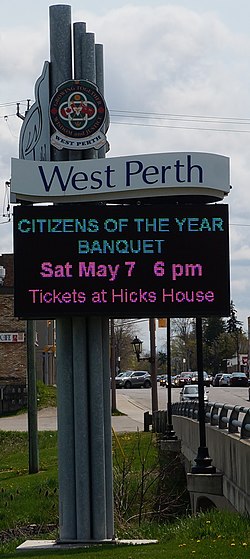Staffa, Ontario
| West Perth | |
|---|---|
| Municipality (lower-tier) | |
| Municipality of West Perth | |
 |
|
| Coordinates: 43°28′N 81°12′W / 43.467°N 81.200°WCoordinates: 43°28′N 81°12′W / 43.467°N 81.200°W | |
| Country |
|
| Province |
|
| County | Perth |
| Formed | January 1, 1998 |
| Government | |
| • Mayor | Walter McKenzie |
| • Federal riding | Perth—Wellington |
| • Prov. riding | Perth—Wellington |
| Area | |
| • Land | 579.42 km2 (223.72 sq mi) |
| Population (2011) | |
| • Total | 8,919 |
| • Density | 15.4/km2 (40/sq mi) |
| Time zone | EST (UTC-5) |
| • Summer (DST) | EDT (UTC-4) |
| Postal Code | N0K |
| Area code(s) | 519 and 226 |
| Website | www.westperth.com |
West Perth is a municipality in Ontario, Canada, situated in Western Perth County, just west of the city of Stratford. In 2016, its population was 8,865 in a land area of 579.36 square kilometers. The former town of Mitchell and townships of Logan, Hibbert, and Fullarton all amalgamated into this single large municipality on January 1, 1998. Municipal offices, administration, and services are based in Mitchell. The mayor is Walter McKenzie.
According to a historic plaque erected by the Province, the Canada Company laid out a town plot (Mitchell) on the Huron Road in 1836. In 1837 a log building was built by William Hicks along Huron Road; he was the first settler in the area. A sawmill was built in 1842 and in 1845, stores and other mills opened. By 1851 the population had reached 150. Mitchell was incorporated as a Village in 1857 after the railway reached the area. Mitchell became a Town in 1874, with a population of 2000. The first mayor was Thomas Matheson. A waterworks system was completed in 1889; roadways and sidewalks were paved that year. Electricity arrived in 1889. By 1901, the population had grown to 2,200 and in 1918, a large new elementary school was necessary. A high school was built soon after.
In 1827, Logan Township was named after Hart Logan, a director of the Canada Company. The first settler to Logan township arrived in 1836. It began to grow considerably when British pioneers arrived in the 1850s; a large German population would begin to arrive in 1853 and settle at Brodhagen. A small village formed in Bornholm and a large inn was built there.
This township was named after William Hibbert, a director of the Canada Company. The first settler arrived prior to 1840 and built a tavern. Although the township was slow in settling, the local economy was strong as a result of rich soil, growing industry and access to transportation for marketing the local produce. One room school houses were in operation until the 1960s after which students began bussing to centralized public and separate schools. The ethnic mix in the area includes English, Dutch, Irish and Scottish.
This township was named after John Fullarton, a director of the Canada Company. The first settler, High Kennedy Junck, arrived in 1832 and later opened a sawmill. Subsequent settlers came from Alsace-Lorraine first and later, in the 1840s, from England, Ireland and Scotland arrived. The town was experiencing major growth in the next decade. A full 3,000 people lived in this area by 1870. According to Stratford-Perth Archives records, the booming town was serviced by "seven schools, many churches, and small businesses such as blacksmithies, wagon and harness makers, country stores, a cheese and butter factory, grist and saw mills, and several hotel taverns". Then, as now, this was primarily an agricultural area.
...
Wikipedia

